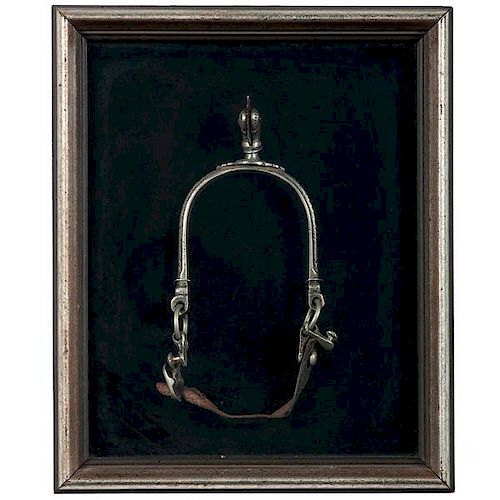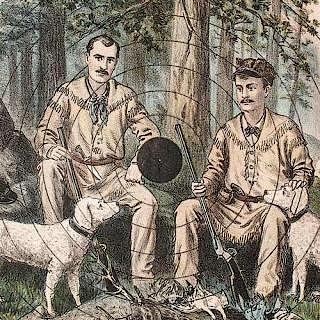Spur Identified as Belonging to Theodore Roosevelt From the Leo Miller Collection
About Seller
6270 Este Ave.
Cincinnati , OH 45232
United States
With offices in Cincinnati, Cleveland and Denver, Cowan’s holds over 40 auctions each year, with annual sales exceeding $16M. We reach buyers around the globe, and take pride in our reputation for integrity, customer service and great results. A full-service house, Cowan’s Auctions specializes in Am...Read more
Two ways to bid:
- Leave a max absentee bid and the platform will bid on your behalf up to your maximum bid during the live auction.
- Bid live during the auction and your bids will be submitted real-time to the auctioneer.
Bid Increments
| Price | Bid Increment |
|---|---|
| $0 | $25 |
| $500 | $50 |
| $1,000 | $100 |
| $2,000 | $250 |
| $5,000 | $500 |
| $10,000 | $1,000 |
| $20,000 | $2,500 |
| $50,000 | $5,000 |
| $100,000 | $10,000 |
About Auction
Nov 20, 2015 - Nov 21, 2015
Cowan's Auctions dawnie@cowans.com
- Lot Description
Spur Identified as Belonging to Theodore Roosevelt From the Leo Miller Collection
A framed, early 20th century South American engraved silver spur marked Garantido(?) identified as belonging to Theodore Roosevelt. The spur descended in the family of Leo Miller, a mammalogist chosen by the American Museum for the Roosevelt-Rodon Brazilian expedition. On the verso of the frame an inscription reads: Spur worn by Ex-Pres. Roosevelt-during the ride of 548 miles through Matto Grosso, Brazil. The total piece measures 9 x 11 in.
Miller's notes documented over 450 specimens and 97 different species in several regions including western Matto Grosso, where Roosevelt reportedly wore the spurs. The collection of mammals gathered on the expedition was the first, and practically only, mammal material the American Museum received from either Brazil or Paraguay at that time. In total the trip gathered 2,000 species of birds and 500 mammals. A digital collection of Leo Miller's notes are currently available on the American Museum of Natural History's digital repository.
The Leo Miller Collection
Lots 219-223
Weary from politics and thirsty for danger, Theodore Roosevelt sought adventure to escape his failures of the 1912 election. After a safari in Africa he looked towards South America and a treacherous, unpredictable waterway aptly named the Rio da Duvida or River of Doubt. Death on the scientific crusade was a very real possibility. Many of Roosevelt's friends fretted over his safety. Laughing in the face of peril he replied, "I have already lived and enjoyed as much of life as any nine other men I know; I have had my full share, and if it necessary for me to leave my bones in South America, I am quite prepared to do so." His chortles silenced when the voyage shifted from a confident trek to a harrowing journey. In Candice Miller's book River of Doubt (2005) she explains, "Compared with the creatures of the Amazon, including the Indians whose territory they were invading, they were all – from the lowliest camarada to the former president of the United States – clumsy, conspicuous prey."
Roosevelt traveled with a large entourage of twenty-two men made up of scientists, explorers, camaradas (guides), his son, Kermit, and mammologist, Leo Miller (1887-1952). The American Museum chose Miller for the Roosevelt-Rodon exploration based on his expertise in tropical regions. His delineative notes documented over 450 specimens and 97 different species in several regions including western Matto Grosso, where Roosevelt reportedly wore the spur offered as Lot 221. The collection of mammals he accumulated was the first, and practically only, mammal material the American Museum received from either Brazil or Paraguay at that time. In total, the 900-mile, 40-day excursion gathered 2,000 species of birds and 500 mammals, but the scientific accomplishments came at a cost.
The men barely survived the journey. While traveling, Roosevelt severely gashed his leg. It became infected and almost killed him. In the middle of their route, a fever rendered him unconscious. When he woke, he said, “Boys, I realize some of us are not going to finish this journey. Cherrie, I want you and Kermit to go on. You can get out. I will stop here.” Kermit refused his father’s wishes and pushed on.
Roosevelt returned to the United States sixty pounds lighter, hobbling on a cane, and too weak to speak above a whisper. He did not “leave [his] bones” on the muddy banks of the Rio da Duvida, he did, however, sacrifice some of his life blood. “The Brazilian wilderness stole away 10 years of my life,” confessed Roosevelt. He never fully recovered from his leg injury and suffered almost constant malarial bouts until his death in 1919.
After the expedition, Miller continued to document and explore South America. In a letter included in Lot 220, Roosevelt expressed how very pleased he was that Miller planned to publish his “Tales” from their adventure in his first book, In the Wilds of South America (1918). His experiences inspired several other fictional stories set in the Brazilian wilderness. All of the books including In the Wilds of South America are offered in Lot 220; five are inscribed by Miller.Some rusting of the rowel, the mark garantido(?) as well as the inside of the spur has some wear from use. The spur retains its original leather straps.Condition
- Shipping Info
-
SHIPPING. At the request of the buyer, Cowan's will authorize the shipment of purchased items. Shipments usually occur within two weeks after payment has been received. Shipment is generally made via UPS Ground service. Unless buyer gives special instructions, the shipping method shall be at the sole discretion of Cowan's Auctions, Inc.. Cowan's is in no way responsible for the acts or omissions of independent handlers, packers or shippers of purchased items or for any loss, damage or delay from the packing or shipping of any property.
-
- Buyer's Premium



 EUR
EUR CAD
CAD AUD
AUD GBP
GBP MXN
MXN HKD
HKD CNY
CNY MYR
MYR SEK
SEK SGD
SGD CHF
CHF THB
THB















